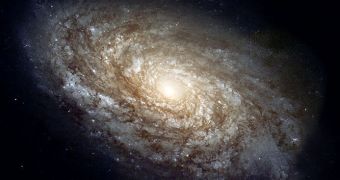Investigators at the Niels Bohr Institute announce the discovery of some low surface brightness galaxies, in a finding that proves these structures are more common throughout the Universe than anyone originally thought.
These galaxies stand out through the fact that they are very small, but also because experts have found them lacking in any of the heavier elements that are common to larger galactic formations.
But these traits also make the galaxies very hard to discover. The international collaboration of astronomers that led the new study realized this first-hand, but did not back down from the challenge.
Interestingly, this special class of galaxies may in fact be extremely similar to the galaxies that developed early on in the history of the Universe, just a few hundred million years after the Big Bang exploded the Cosmos into being.
One of the galaxies the team focused its efforts on is called ESO 546-G34. It was first observed more than two decades ago, but thus far astronomers failed to realize how special the formation was. The team figured this out by applying new study method to the structure.
“The galaxy gives us an idea of how the galaxies must have looked before star formation really got going,” says NBI Dark Cosmology Center (DCC) astrophysicist Lars Mattsson. The NBI is based at the University of Copenhagen.
ESO 546G-34 stands out even among its class, due to the fact that it contains negligible amounts of chemical elements heavier than oxygen and nitrogen. Even the two, lighter elements are found in barely noticeable amounts.
The new study has determined that more than half of the cosmic structure is represented by hydrogen gas. More evolved galaxies, such as our own, have several times less hydrogen, as the gas is being constantly consumed to create new stars.
Astronomers at Uppsala University and the Astronomical Observatory, in Kiev, the Ukraine, also contributed to the new research, details of which appear in the latest issue of the esteemed scientific journal Monthly Notices of the Royal Astronomical Society.
“Our analysis shows that while a large, mature galaxy like our own galaxy, the Milky Way, is comprised of around 15-20 percent gas, this faint little galaxy is comprised of up to 50 percent gas and is very poor in heavier elements,” Mattsson says.
“This means that it is very unevolved,” the expert concludes, quoted by Daily Galaxy.

 14 DAY TRIAL //
14 DAY TRIAL //